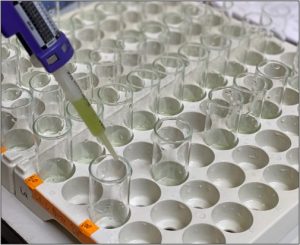Quality-assurance recommendations developed to improve Ceriodaphnia toxicity test

An expert science panel has developed best-practice recommendations for improving the quality and consistency of a toxicity test commonly used in California to monitor the water quality of treated wastewater and stormwater discharges.
The recommendations, published as a statewide guidance manual in September, were developed following a two-year, multi-phased investigation examining multiple aspects of the culturing and testing procedures that could account for variability in results for the Ceriodaphnia dubia survival and chronic reproduction test. The toxicity test, which uses the C. dubia water flea, has been in use since the mid-1980s.
The study found that about half of laboratories were able to consistently produce high-quality testing data. For the other half, the study concluded that the variability was most likely a result of multiple causes that are unique to individual laboratories and might be occurring on an intermittent basis.
Laboratories have some flexibility under California’s approved C. dubia testing method to adapt exactly how they perform the test, including limited options for what to feed the test organism, the laboratory reagents used to create dilution water, and age of the organisms used to initiate the test.
In response to the findings, the study’s expert science panel developed a series of recommendations to help ensure that: (1) laboratory methods are implemented and documented consistently, (2) California’s accreditation process is optimized to document laboratories’ comparability, and (3) training is improved for all parties, including State assessors, laboratories and regulated agencies.
The panel also proposed a list of metrics that could be used to monitor laboratory performance and achieve desired levels of sensitivity, consistency and comparability.
Environmental managers have used the C. dubia test for decades as part of a suite of toxicity tests to protect California’s enclosed bays, estuaries and inland water bodies from contaminated discharges. But in recent years, end users of the C. dubia test have expressed growing concerns about accuracy, repeatability and consistency associated with interpreting test results.
These concerns came into sharp focus in 2020, as the State Water Resources Control Board was preparing to adopt numeric water-quality objectives for a full suite of aquatic toxicity tests – a policy change known as the Toxicity Provisions.
In response to end-user concerns about the C. dubia test, the State Water Board postponed implementing numeric objectives for the C. dubia test until 2024. The numeric objectives for other toxicity test species were adopted in late 2020.
In 2020, both the regulated and regulatory communities asked SCCWRP to facilitate the study to investigate the sources of variability in C. dubia test results.
The study – led by a five-member expert science panel with input from a 10- member stakeholder advisory committee – began by compiling data from about 1,000 C. dubia toxicity tests performed by the 17 laboratories accredited to perform the test in California. The historical analysis found that while most laboratories could meet test acceptability criteria, several laboratories exhibited high variability with low reproducibility.
Next, study participants conducted an initial round of split-sample intercalibration testing and found that no two laboratories performed the C. dubia test exactly the same way – a finding that confounded researchers’ ability to pinpoint which technique might be the source of variability.
After identifying areas of inconsistency and developing test techniques intended to reduce variability in test results, researchers then conducted a second intercalibration exercise. The second intercalibration exercise found that bringing more standardization to the laboratory techniques reduced but did not remove test variability among the laboratories that were producing inconsistent data.
The study’s findings were presented during a State Water Board meeting in mid-October. During the hearing, regulated parties said they agreed with many of the recommendations, and expressed confidence that the C. dubia test methods can be reliably performed by a competent laboratory. However, concerns were expressed that an insufficient number of laboratories can perform the test well, especially given the large number of required compliance tests mandated statewide, and that the C. dubia Toxicity Provisions were being implemented prematurely before the study’s recommendations can be fully implemented. The C. dubia numeric objectives are scheduled to go into effect in January 2024.
The final technical report and other project materials are available on the project’s webpage.
For more information, contact Dr. Alvina Mehinto and Ken Schiff.
More news related to: Runoff Water Quality, Top News